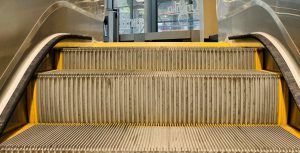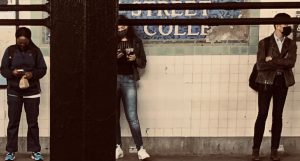
In-person learning isn’t the return to normal Sara Lops thought it would be. The human biology senior is surprised that even a simple conversation with a classmate–something that seemed second nature not that long ago–overwhelms her.
“I feel as if I lost some sliver of an ability to communicate with somebody in person rather than online,” says Lops. “I have definitely noticed seeing myself and hearing myself getting nervous and stuttering a lot more than before.”
Because the surge of the COVID-19 delta variant is still a concern for many, students are finding it hard to get out of the coronavirus mentality.
While remote, students had to work harder to build relationships and socializing became almost non-existent. “We literally came back from a two-year quarantine and an all remote school year, so to jump headfirst into a large sea of being in person, it can be a lot to handle,” says Lops.
This is the case for Veronika Lleshi, a junior who spent most of her freshman and sophomore year remote learning. “Going to this from the germophobia the pandemic instilled in me is a little difficult, especially with all these variations popping up,” said Lleshi. “I’m just trying to protect myself as best as I can.”
This is just one of the many struggles students are dealing with as they acclimate to on-campus learning.
For junior and media major Melina Jorge, the challenge comes from time management skills. On top of online learning offering additional leisure time and school existing a few feet from her bed, Jorge’s professors were more merciful with work. “Professors were a bit more understanding and lenient with deadlines and now they expect work to be printed and handed in before teaching the class–online everything just needed to be submitted by the end of the semester,” says Jorge. “The workload is more.”
While students re-adapt to in-person learning, educators are also recognizing their struggles. English Professor Sarah Davis says that she is still giving her students leeway, just in different ways now.
This semester Davis is teaching both hybrid and in-person classes. In an effort to meet students where they are, she surveyed the class on individual learning preferences. “They overwhelmingly stated a preference for virtual classes due to safety concerns, convenience for their work schedules, family responsibilities and the commute,” says Davis. In addition, if students need to quarantine, Davis offers assignment extensions as a way to grant them some leniency.
Davis says, “I tell students at the beginning of the semester that we have no way of knowing what things are like for each other, therefore we should work from a place of good intentions and try to support each other.”

Commuting was a big concern for Davis students. And for Victoria Palmieri, the media studies major, this is where her biggest pressure comes from. “I have to take three trains to get to school, and it gets exhausting,” says Palmieri. “It gets hard to manage all of my school work when so much of the day is dedicated to in-person classes and commuting.”
Virtual learning took a toll on the academic experience, according to some professors.
Journalism professor David Alm says that remote learning did students a disservice. “Online learning was a poor substitute for in-person and unfortunately some students did not get nearly as much out of their courses as they might have otherwise,” Alm said. This now means having to re-teach and go over material and skills that should have been learned in the previous course.
Sophomore and history major Roneque Simons can relate that distance education may have provoked some learning disadvantages. “I feel overwhelmed because of how different in-person learning is from virtual learning. I had been getting used to virtual learning just to have it taken away,” she says. “The load in assignments now feels a lot more and so overwhelming and maybe it isn’t, but I don’t feel prepared. I’m just taking it one day at a time.”

